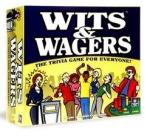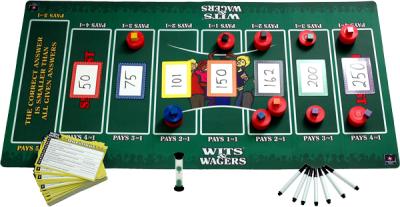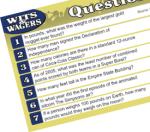 Wits and Wagers Review
Wits and Wagers Review
 Self-captioned “Trivia for people who don’t know stuff,” publisher North Star Games’ Wits and Wagers [Amazon, Funagain] attempts to mix things up the trivia genre. Instead of players straight-up answering stock trivia questions on pop culture or mainstream history, the questions hit the edge obscurity requiring players to ballpark a guess at the answer. This increased challenge is balanced by betting phase where people stake points on which guess is the closest answer without it going over (every answer is a numerical value). This layer of abstraction keeps everyone involved and entertained throughout, and makes Wits and Wagers a great addition to anyone’s stack of party or trivia games. In fact, it conrasts some older titles in the trivia game genre, making them seem like the dinosaurs that they are.
Self-captioned “Trivia for people who don’t know stuff,” publisher North Star Games’ Wits and Wagers [Amazon, Funagain] attempts to mix things up the trivia genre. Instead of players straight-up answering stock trivia questions on pop culture or mainstream history, the questions hit the edge obscurity requiring players to ballpark a guess at the answer. This increased challenge is balanced by betting phase where people stake points on which guess is the closest answer without it going over (every answer is a numerical value). This layer of abstraction keeps everyone involved and entertained throughout, and makes Wits and Wagers a great addition to anyone’s stack of party or trivia games. In fact, it conrasts some older titles in the trivia game genre, making them seem like the dinosaurs that they are.
Yes Trivial Pursuit, you dice tossing and inconsistently challenging spawn of ancient early-1980s gaming culture, we’re looking at you.
Slightly tarnished by the inclusion of some cheap components, Wits & Wagers’ gameplay shines through its foggy exterior to deliver a fast paced and most importantly fun 20-30 minute trivia party game that's well worth your time.
Read on for a more detailed breakdown in our full review.

The Pieces and Rules
Each player has a dry-erase whiteboard, a dry-erase pen, two betting tokens to mark their bets on the board, and a pool of chips that they’ve won through smart play. Sitting between everybody is a felt cloth board with a linear series of spaces on it. Each space has a payout value ranging from 4:1 on both edges and 1:1 in the center. Aside from a sand timer, and a deck of trivia cards, that’s it.
The short of it: Everyone attempts to answer the question, and then everyone bids chips on which player guesses they think are the closest to (without going over) the correct answer. The answer doesn’t have to be correct, but the best approximation. Money is awarded to those who bet wisely, and a few pennies are also tossed to the player(s) who actually wrote down the correct answer on their whiteboard. It’s a nice little bonus when it happens.
The long of it: The game lasts seven rounds and kicks off with a designated question reader who draws a card and asks a trivia question. Every question has been phrased so that there’s a numerical answer -- some of the questions we’ve encountered have been things like “What year did Ben Franklin perform his famous kit experiment?” or “How many people has Jack Bauer killed in the first five seasons of 24?” The questions have a great level of “how the heck would I know that?” while still allowing people to have a general ballpark guess of the answer. This is a major key to the game’s success – the answers in this stage of the game don’t have to be right, and most people – even the smarty pants – won’t know the answers , either.
Players write down their guesses on their personal dry erase board and then hand them in before the 30 second timer expires. The answers are then sorted into a line of ascending values by the Answer Wrangler, who could be anyone who can count. The one answer that sits in the middle of the pack of ordered answers becomes the focal point for the ratio payout spaces on the board. It’s placed on the 1:1 payout ratio space, with the insinuation this is probably the most safe / accurate estimation of the answer to the question. Them the other answers are spread out on the board from there, with the answers above the middle guess being placed on the 2:1 payout ratio space, then 3:1, and the 4:1 above the middle guess, and the lower-value number answers spans the other way to the left on track along the another series 2:1, 3:1, 4:1 payouts. Therefore the further each guess is from the center ‘safe guess’, the higher the payout will be if that answer turns out to be correct. There’s also a space that allows players to bet a catchall of “Every Guess is too High” at 5:1 odds, which is the equivalent of betting 1 dollar on the Price is Right.
Players then can place two different bets using their bet markers, and may wager up to 10 chips of their earned chips. This part is timed, and players can move their bets around up until the point when time expires. This is a great mechanic, as sometimes people follow a player’s bets if they know a lot about the subject of the question, and only at the last minute does that player move to switch their bet and hoodwink everyone else. A lot of cheers and jeers come out of some last second bet moves. So much so that it became a strict rule that a player’s chips had to be on the mat for their bets to count; some of the last minute shuffles were lifted off the mat, and time expired before they were frantically placed again. Oooh sorry Billy – No action!
After the payouts have been made and the chips have been raked-in, the game goes through 6 more rounds (7 question rounds in total). On the last round the 10 chip limit is lifted and any player can bet all of his/her chips for a last ditch stake to win the game.
Critique Time
 The Bad:
The Bad:
Before we get into the fun factor we wanted to cover our to two main beefs with this game. #1 is that some of components feel pretty cheesy. The dry erase markers are fairly low hanging on the Quality Board of Excellence, with pen caps that that fall of the backs of pens, and some other elements that seem pulled off the shelve of a wholesale Staples store. Also the game ships with plastic poker chips - which we hate. It’s not that we hate anything specific about these particular chips – they’re your standard drug-store purchased poker chips - but we absolutely hate the feel of plastic poker chips, the sound of plastic poker chips, and their ironic and stubborn resistance plastic poker chips have to being neatly stacked.. We recommend substituting-in your own clay chips to play. If you don't have them, then you don't know what you're missing. Every other component is just OK, with the exception of the board which is Nice.
Our second major beef is that in some sessions one player can runaway with the score after a short series of good guesses. Even with the last ditch no-limit betting at the end of the game, a player could collect a mountain of chips and their lead becomes insurmountable. It doesn’t happen often, and if you treat this as the light hearted party game it is, then this beef really doesn’t hold water anyway. OK, you got us; we just needed something else to complain about.
The Good:
Just about everything else is great if you’re looking for a FUN trivia party game. The game succeeds well in its efforts to strip the skill of Trivia away from the braniacs, and then empowering everyone – including said brainiacs - through the educated selection of multiple choice answers produced by the players themselves. The payoff distribution also ensures that every round will cause players to game for not only the correct answer, but the process of distributing their chips across two answers: one could act as a mainstay guess, and another a safety bet with a higher payoff.
Lastly the game enters a nice frantic mode in the closing seconds of the betting round when people try to ditch competitors who consistently follow their lead by changing their bet at the very last second. Feints are a key element to the game and add a nice exciting edge to the end of the round.
Conclusion
Wits and Wagers very successfully executes a combination of a trivia game with betting strategy elements and packages it into a very fun party game. It blows the gameplay of Trivial Pursuit out of the water: every player is active in every portion of the game, and no one player receives a series of “easy questions” about frogs in Science that propels them into the lead while everyone else squanders on questions like “Who was the first circus clown?” in Arts and Entertainment.
The title’s cheap components are forgiven after fun-factor of the game shines through on the first play, and most often we’re driven to play repeated sessions of it before we put it back in the box.
Wits & Wagers is a great title to cap off a dinner party, to act as a warm-up game on game night, or to break the ice between different cliques of friends. We highly recommend it to anyone looking for a great trivia / party game.
Raiting: 4 out of 5 (our rating system)
Read More in: Board Games | Our Game Reviews | Party Games
Share this Article with others: 
Related Articles:
Came straight to this page? Visit Critical Gamers for all the latest news.
Posted by Critical Gamers Staff at October 24, 2007 5:09 PM
